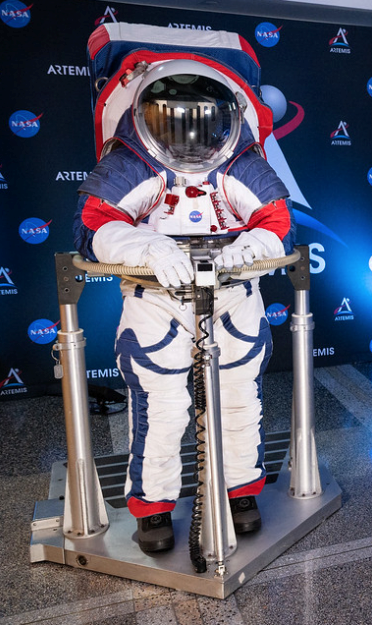Spacesuits for the next generation
NASA has unveiled two new spacesuit designs that will be used for the Artemis program moon missions.

Source | NASA
Last week NASA (Washington, D.C., U.S.) unveiled two new spacesuit designs — a new Exploration Extravehicular Mobility Unit (xEMU) and the Orion Crew Survival System (OCSS) suit — that will be used for the Artemis program moon missions. The next-generation spacesuits were presented by Amy Ross, a spacesuit engineer at NASA’s Johnson Space Center, and NASA Administrator Jim Bridenstine on Tuesday, October 15, 2019 at NASA Headquarters in Washington D.C. The suits were demonstrated by Kristine Davis, a spacesuit engineer at NASA’s Johnson Space Center and Dustin Gohmert, Orion Crew Survival Systems Project Manager at NASA’s Johnson Space Center, who wore the xEMU and OCSS respectively.

Artemis generation xEMU spacesuit Source | NASA
The xEMU suit offers much improved range of mobility over suits currently in use for extravehicular activity (EVA) and certainly over suits worn for the Apollo era moonwalks, which evoke images of stiff-legged astronauts bunny-hopping across the lunar surface. Circular bearings in the shoulders and waist of the new xEMU, as well as 3 bearings in the legs allow the wearer to walk and perform tasks much more easily than spacesuits have allowed in the past. The suit has a rear-entry hatch making it easier to for astronauts to suit-up. The suit is also modular in its design so that it can be configured for spacewalks or for planetary surfaces and different environments – plus its modular nature makes it easy to update as technologies evolve.
The new xEMU appears to have much in common with NASA’s Mark 3 space suit design, a NASA technology demonstrator aimed at enabling surface exploration and also NASA’s Z-2 spacesuit prototype, which was designed specifically for Mars. Both the Mark 3 and the Z-2 were built by ILC Dover (Frederica, Del., U.S.) and both feature carbon/epoxy torso and hip elements in the design. (Learn more about NASA’s Z-2 spacesuit prototype here.)

Orion Crew Survival System spacesuit Source | NASA
NASA also revealed the OCSS spacesuit, designed as a pressurized launch and entry suit for Orion crewmembers. In the event of loss of cabin pressure, the OCSS can sustain an astronaut for up to six days. Improvements to the suit over shuttle-era launch entry suits (LES) include a lighter, stronger helmet, updated communications equipment, an improved cooling system, touch screen compatable gloves, improved fire resistance and CO2 scrubbing.
While NASA has not released details on the materials incorporated into its new spacesuit designs, it’s probably a safe bet that a fair amount composites are involved. Shuttle era launch entry suits featured an outer layer of DuPont’s (Richmond, Va., U.S.) flame-resistant meta-aramid Nomex, and previous Extravehicular Mobility Units (EMUs) have utilized combinations of Nomex, the para-aramid Kevlar (also developed by DuPont) and Gore-Tex, a waterproof, breathable fabric membrane manufactured by W.L. Gore & Assoc. (Newark, Del., U.S.).
Related Content
-
Plant tour: Albany Engineered Composites, Rochester, N.H., U.S.
Efficient, high-quality, well-controlled composites manufacturing at volume is the mantra for this 3D weaving specialist.
-
Commingled yarn solutions provide flexible thermoplastic prepregs
CAMX 2024: Concordia Engineered Fibers presents customizable commingled yarn solutions, including environmentally friendly options.
-
Real-time assessment of thermoset composites curing
The combination of material state management (MSM) software and an encapsulated sample rheometer (ESR) enables real-time cure recipe management or cure model development inside the autoclave.
















